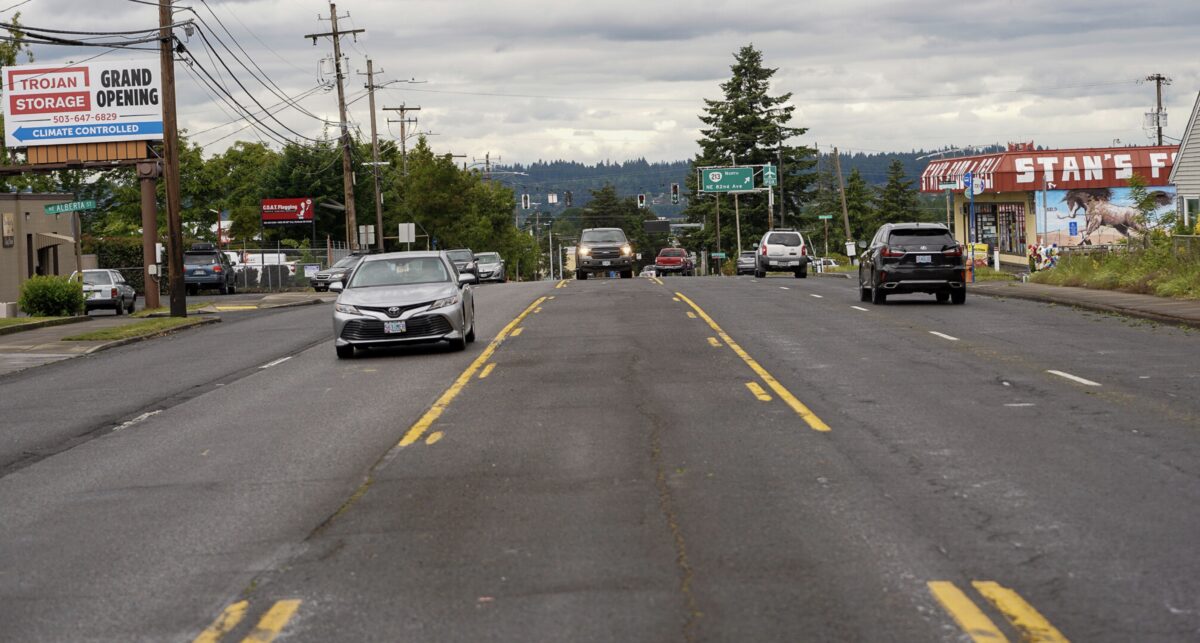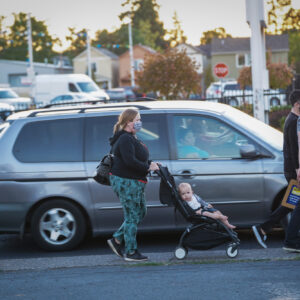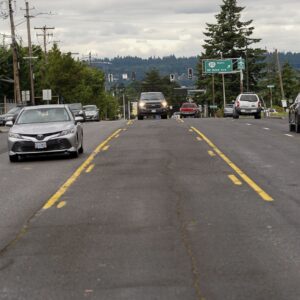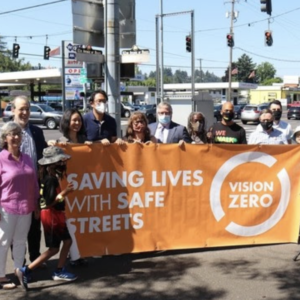
(Photo: Jonathan Maus/BikePortland)
The latest step in the transfer of 82nd Avenue from state to city hands is a request for proposals (RFP) released today by the City of Portland that seeks a consultant to change it from a busy, sprawling orphan highway dominated by drivers and surface parking lots, to a dense “civic corridor” full of people and multimodal activity.
The RFP also gives us new details on how the City of Portland plans to use the $185 million influx of funding 82nd has recently attracted ($35 million from Portland Bureau of Transportation, $105 million from ODOT, $80 million from the federal American Rescue Plan Act).
Calling it the 82nd Avenue Civic Corridor Transportation Investment Program, the City of Portland says the consulting agency who wins this $8 to $12 million contract will be responsible for creating a new design of 82nd that moves it toward becoming a “civic corridor” as envisioned in the city’s 2035 Comprehensive Plan and that aligns with previous plans already adopted by the city.
Civic corridor is a specific land use designation defined in chapter 3 of the Comp Plan. Here’s more from the plan:
Advertisement
“Civic Corridors are the city’s busiest, widest, and most prominent streets. They provide major connections among centers, the rest of the City, and the region. They support the movement of people and goods across the city, with high levels of traffic and pedestrian activity. Civic Corridors provide opportunities for growth and transit-supportive densities of housing, commerce, and employment. Development in Civic Corridors is intended to be up to mid-rise in scale, with lower scale generally more appropriate in locations far from the Central City or transit stations. Mid-rise development typically ranges from five to seven stories.
Abundant trees and high-quality landscaping beautify Civic Corridors and offset the impacts of their large paved areas. These corridors exemplify the benefits of green infrastructure by cleaning and soaking up stormwater runoff and minimizing urban heat island effects, while also being enjoyable places to live, work, and gather. Civic corridors are safe for all types of transportation. Civic Corridors policies apply to the roadway, the public realm of the street, and the buildings that line the street.”
Civic corridors are further defined in the Comp Plan as places, “that are attractive and safe for pedestrians while continuing to play a major role in the City’s transportation system.” 82nd is currently one of the most unpleasant and dangerous places for walking in the entire city.
The RFP specifically calls out four “overarching investment areas” that have extensive needs: safety, transit, maintenance/repair, and equitable development.
Another notable part of the RFP says the consultant might also lay the groundwork for a future project along the 82nd corridor that, “could include bus rapid transit or other transit investments as well as other potential changes to the roadway to fulfill the Civic Corridor vision.”
The RFP says the consultant’s work needs to be done by 2024 in order for construction to start by 2026.
See more details by downloading a PDF of the RFP here.
— Jonathan Maus: (503) 706-8804, @jonathan_maus on Twitter and jonathan@bikeportland.org
— Get our headlines delivered to your inbox.
— Support this independent community media outlet with a one-time contribution or monthly subscription.






Thanks for reading.
BikePortland has served this community with independent community journalism since 2005. We rely on subscriptions from readers like you to survive. Your financial support is vital in keeping this valuable resource alive and well.
Please subscribe today to strengthen and expand our work.
I’m not optimistic that any worthwhile plan to wrest 82nd from the tyranny of the automobile will ever be enacted. I’d love it if it were, but given just how much of an uproar there’s been over a few miles of Foster going on a road diet, and how much of a car dealership row 82nd is, the pushback is going to be enormous.
There was pushback on Foster yes, but to its credit the city and PBOT held firm with neighborhood and community groups watching to make sure they did. Yes there are some wealthy businesses along 82nd, but there are a lot more people than businesses, as well as powerful community groups (e.g. APANO).
Foster would actually be a pretty good model for 82nd. I don’t see how they make the sidewalks reasonable without eliminating a lane (unless they plan to deploy eminent domain, which seems unlikely). And once that’s on the table than the entire streetscape is going to change anyway. With 205 right nearby, there’s zero reason to prioritize fast vehicular traffic. One lane in each direction, with or without a center turn lane, would allow for walkable sidewalks, tree planting, protected bike lanes, and transit-priority slip lanes where necessary.
In any case, let’s not pre-emptively concede!
It will take a rebuild to expand the sidewalks; if they do that, the bike bill gets triggered. It will be ignored, of course, unless someone takes PBOT to court. I can’t imagine The Street Trust doing something assertive that could upset their vassal status with PBOT/ODOT, and BikeLoud doesn’t have the capacity. We need our old BTA back!
Agree that foster could be a good model, but instead of the bike lanes, we should put in Rose Lanes which are like wide bike lanes that can also take buses. The 72 would get a big boost
What is the distinction between a Civic Corridor and a Civic Main Street in terms of design? The PBOT transportation System Plan map lists about half of 82nd as a Civic Main Street, not simply a Civic Corridor.
https://www.portland-tsp.com/#/streets
I don’t have much hope in the short term, but I’d love to see a separated bike lanes on either side of 82nd. That would really follow the spirit of the “multimodal mobility” goal.
Since they are using so much ARPA funding, and those funds expire (must be used by) on Dec 31st 2025, 82nd should be started and completed in record time (at least by PBOT’s rather uninspiring record.)
“…any amount awarded to a State out of amounts appropriated by
this section shall be expended by the State by September 30, 2025.”
Actually, that’s rather helpful, thanks – I’m assembling an application for ARPA funds from my community, which has set aside $25 million for local nonprofits from the $59 million total for our community – and that date will need to be honored on my proposed budget.
When tolls are put on I-205, some motorists will likely try some alternative routes. The most obvious is 82nd Street. I’m objecting to either the tolls and the reconfiguration of 82nd aren’t appropriate, but they may conflict and have interrelated and intended consequences.
Precisely one of several reasons why I don’t support any tolls. Look at cities like DC (a place I’ve spent significant time) where the primary interstate into the city (I-66) is tolled. Massive backups on surface streets that hurt livability. Get the traffic off the surface streets and onto the freeway where it belongs. Put 82nd on a road diet to one car lane in each direction with protected bike lanes and one center-running BRT lane, keep I-205 free.
Do we know where the proposed tolling locations will be? I was under the impression that they would only be around the bridge in Oregon City, where few alternatives exist.
Tolls _should_ be at the Columbia and in Oregon City where there are no alternative routes. Since ODOT wants this to fail, they’ll do something else.
Just wait for the Hummertron EV3000 that will give you the “freedom” to deploy floats to drive across rivers and avoid all those tolls that you didn’t choose.
It hasn’t been fully determined, but they’re looking to toll all of I-5 and I-205 from Columbia River south the the Boones Bridge in Wilsonville. https://www.oregon.gov/odot/tolling/Pages/I-5-Tolling.aspx
“Abundant trees and high-quality landscaping beautify Civic Corridors and offset the impacts of their large paved areas. These corridors exemplify the benefits of green infrastructure by cleaning and soaking up stormwater runoff and minimizing urban heat island effects, while also being enjoyable places to live, work, and gather. Civic corridors are safe for all types of transportation.”
Does such a thing exist anywhere in Portland?
SW Moody Ave, but it is underneath the concrete of the I-5 freeway and people drive very fast on it and far above the speed limit.
Looks like these are “civic corridors”:
https://gis-pdx.opendata.arcgis.com/datasets/7eb527231517499ca7781ae67b50dc74/explore?location=45.518150%2C-122.625350%2C12.27
But you’re certainly right to question whether any exist that meet that definition. Most seem to be the opposite.
I think the SE Division Main Street / Green Street (12th-Cesar Chavez) did a pretty good job of this.
What?! No “Gateways made of rainbows greet you as unicorns frolic in meadows filled with love, equity, and non-violence.”?
Do you know why regressive politicians are so successful and why fossil fueled transportation lobbyists and business interests kill our plans? SIMPLE MESSAGING. For example, “If PBOT builds this fantasy project, your taxes will be used to drive 70% of the businesses and jobs on 82nd Avenue away, put reckless drivers in your neighborhoods and your children’s school zones, and the whole thing will just become a squalid homeless camp inside of six months!”.
Now, which tactic resonates with the common voter who doesn’t read BikePortland, does not understand transportation planning, and is just trying to get through daily life as best they can?
Instead of writing a fragrance commercial, tell them, “This project will create good jobs, make your neighborhoods safer, boost your property value, and get rid of the ugliness and filth that has plagued 82nd Ave. for decades.”.
2026?! I don’t want to water down the final results, but can we just get started already?! Add jersey barriers everywhere, put dividers and pedestrian islands down the center in most spots, plant some trees, narrow the lanes and extend the sidewalks into the road with asphalt. Add diverters everywhere on local neighborhood roads to limit the cut through traffic that’s already bad. Done! Then come back for the “big fix” in five years.
…but you still need to form your stakeholder advisory committee, hire expensive national consultants, have a year’s worth of meetings, then a public open house or four, and at least two major redesigns by PBOT and ODOT staff…
Woah, slow down there bud. We have a backlog of high-cost consultants that need to milk this for all it’s worth. This is just the first of many RFPs!
PBOT will need to ‘engage’ with the community to ‘understand the problems’ because it’s totally not obvious to everyone why 82nd is miserable to walk, bike, or drive on and through!
If we deploy evidence-based solutions to known problems, how will consultants afford a new Tesla this year you monster!
Yeah I can’t wait for them to cave to the Used Auto Dealer special interest lobbying groups that will try and sink any good that will come from this.
No compromises. Let’s put a dedicated bus rapid transit/bike lane down the middle of 82nd!
https://www.82ndaveba.com/
My reading of the RFP is that it stipulates that the construction phase of the project be completed by 2026 (Page 8, sections 1.3 and 1.4):
“The schedule for performance of Services needed under the prospective Contract is approximately January 2022 through December 2026. Phase I (project development, conceptual design, and NEPA documentation) is expected to be completed in 2022. Phases II and III will be completed by December 2024, with Phase IV complete by December 2026.”
Still too long of a timeline, but not quite as long as it might have initially seemed.
Why on earth does it cost that much to hire a consultant? It feels like a grift.
Couldn’t we open this up to grassroots groups to come up with a plan? Maybe the people that live there? This is just part of a perpetual cycle in top down governance that leads to endless talking, planning, and developer tax bonanzas.
$12M for design on an $80M project is a totally normal ratio. Design plans take a lot of specialized engineering hours.
Oh please no. I love me some grassroots orgs, but this type of stuff demands expertise and to get the good ones they don’t come cheap! I’m with you on the frustration about endless planning.. But I’m all for paying smart people to do complex work!